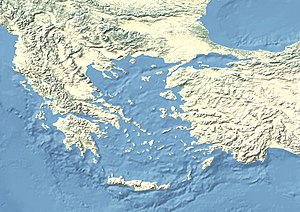
In Greek mythology, Hippolyta, or Hippolyte, was a daughter of Ares and Otrera, queen of the Amazons, and a sister of Antiope and Melanippe. She wore her father Ares' zoster, the Greek word found in the Iliad and elsewhere meaning "war belt". Some English translations prefer "girdle". Hippolyta figures prominently in the myths of both Heracles and Theseus. The myths about her are so varied it is thought that they may be about different women. The name Hippolyta translates as "she who unleashes the horses", deriving from two Greek roots meaning "horse" and "let loose".
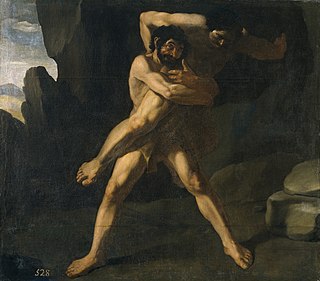
Antaeus, known to the Berbers as Anti, was a figure in Berber and Greek mythology. He was famed for his defeat by Heracles as part of the Labours of Hercules.
In Greek mythology, Acherusia was a name given by the ancients to several lakes or swamps, which, like the various rivers called Acheron, were at some time believed to be connected with the underworld, until at last the Acherusia came to be considered to be in the lower world itself.

Zanclus is the legendary first king of the Sicilian city of Messina. He is mentioned in an etiological passage by Diodorus of Sicily, and has become a symbol of Messina. In modern Italian, the form is given as Zanclo.
Selymbria, or Selybria (Σηλυβρία), or Selybrie (Σηλυβρίη), was a town of ancient Thrace on the Propontis, 22 Roman miles east from Perinthus, and 44 Roman miles west from Constantinople, near the southern end of the wall built by Anastasius I Dicorus for the protection of his capital. Its site is located at Silivri in European Turkey.
Clearchus was a citizen of Heraclea on the Euxine who was recalled from exile by the oligarchy of that city to aid them in quelling the growing discontent and demands of the people. According to Justin, Clearchus reached an agreement with Mithridates of Cius to betray the city to him on the condition that Clearchus would hold the city for Mithridates as governor. But, Clearchus then came to the conclusion that he could make himself master of the city without the aid of Mithridates. So he not only broke his agreement with the Mithridates, but also captured him and compelled him to pay a large sum for his release.
Ptolemaeus or Ptolemy was a nephew and general of Antigonus I Monophthalmus, one of the Successors of Alexander the Great. His father was also called Ptolemy and was a brother of Antigonus. Ptolemy, the nephew, was Antigonus's right-hand-man until his son Demetrius took on a more prominent role.
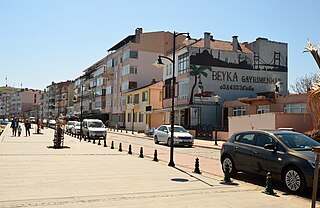
Marmara Ereğlisi, also spelled Marmaraereğlisi, is a municipality and district of Tekirdağ Province, Turkey. Its area is 175 km2, and its population is 29,549 (2022).
In Greek mythology, Praxithea was a name attributed to five women.
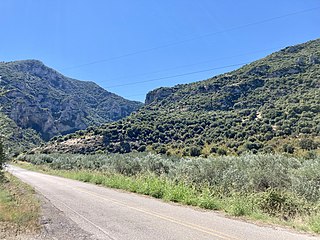
Heraclea (Herakleia) in Trachis, also called Heraclea Trachinia, was a colony founded by the Spartans in 426 BC, the sixth year of the Peloponnesian War. It was also a polis (city-state).
Lysippe is the name of several different women in Greek mythology:
In Greek Mythology, Phaeax was a son of Poseidon and Korkyra (Cercyra), from whom the Phaeacians derived their name. He was the father of Alcinous and Locrus.
Lanassa was a daughter of king Agathocles of Syracuse, Sicily, Magna Graecia, perhaps by his second wife Alcia. In 295 BC, Agathocles married Lanassa to King Pyrrhus of Epirus. Agathocles himself escorted his daughter with his fleet to Epirus to her groom. Lanassa brought the island of Corcyra as dowry into the marriage. The couple had one son, Alexander. However, Lanassa could not accept her husband's polygamous lifestyle, and so she left Pyrrhus in 291 BC, went to Corcyra, and offered this island as dowry to Demetrius I Poliorcetes, then king of Macedonia, if he would become her new husband. The courted diadoch came to Corcyra, married Lanassa, and occupied the island. After the death of Agathocles Pyrrhus, as former husband of Lanassa, asserted hereditary claims to Sicily. On the basis of these claims, the inhabitants of Syracuse asked Pyrrhus in 279 BC for assistance against Carthage.
Astacus is an ancient city in Bithynia; it was also called Olbia. Its site is located near the modern Başiskele.
Caenophrurium was a settlement in the Roman province of Europa, between Byzantium and Heraclea Perinthus. It appears in late Roman and early Byzantine accounts. Caenophrurium translates as the "stronghold of the Caeni", a Thracian tribe.
Apollodorus was an Athenian general of the 4th century BCE. He commanded the Persian auxiliaries which the Athenians had solicited from the king of Persia, Artaxerxes III, against Philip of Macedon in 340. Artaxerxes, who was keen to block the advance of Philip, ordered his satraps to render all aid they could, and the satrap Arsites stepped in to provide mercenaries. Apollodorus became engaged with these troops in protecting the town of Perinthus while Philip invaded its territory. Apollodorus's forces had laid in significant provisions, and successfully repelled the siege.
In Greek mythology, Creusa was an Athenian princess.
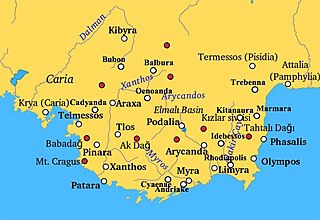
Marmara was a town of ancient Lycia, whose inhabitants put up a ferocious defense to Alexander the Great during his invasion. The name does not appear in history, but the ethnonym is cited by Diodorus Siculus. The town's territory is called Mnarike in the Stadiasmus Patarensis, implying a town name of Mnara.

Edith Schönert-Geiß was a German numismatist, who specialised in the classical coinage of Thrace and was instrumental in the post-war re-establishment of the Corpus Nummorum.
In Greek mythology, Peteus or Peteos or Petes (Πέτην) was a member of the Athenian royal family as the son of Orneus, son of King Erechtheus. In some versions of the myth, Petes was originally an Egyptian, who later obtained Athenian citizenship.
